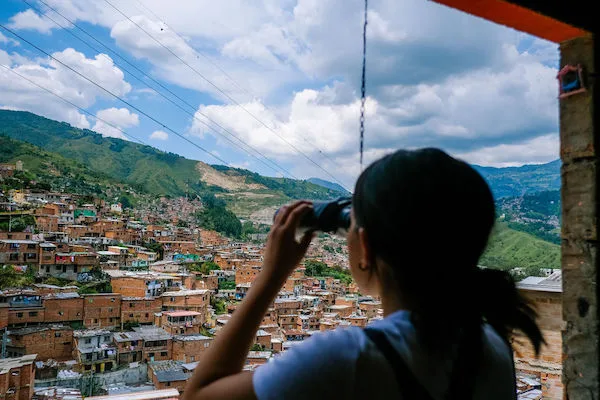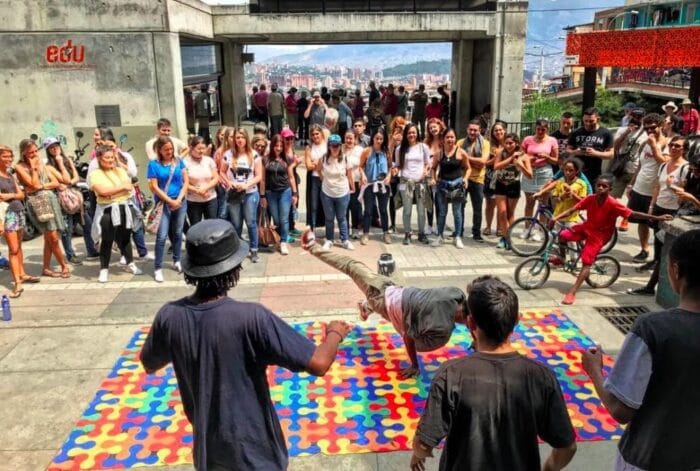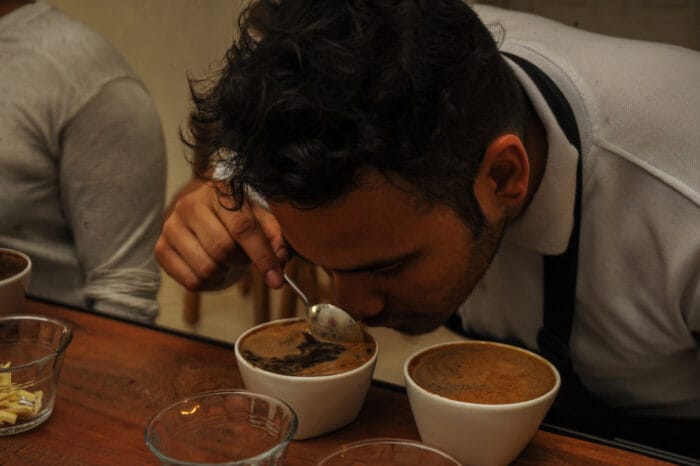Travel insights from Latin America
Medellin: Ultimate Travel Guide

All Medellin visits start with love at first sight.
Set in a sultry valley, this city boasts clusters of immaculate terracotta-colored buildings stacking up to the clouds, occasionally sprawling up surrounding mountains that sprout olive-green forests.
Be warned though, the story of Colombia’s City of Eternal Spring is just beginning. We take you into neighborhoods to discover a new wave of urban artists.
Previously no-go areas display world-class street art and chime with the beats of rap and hip-hop. You can visit transformative social projects, foundations, innovative pioneers and bringing you closer to the city’s transformation. And in nearby restaurants, you can enjoy plates of crimson beans, plantain, avocado and freshly-brewed coffee.
Medellin travel – essential information
Medellin is accessed via its international airport in Rio Negro which is a 45-minute drive from the city. Direct flights are available from many US cities, with more opening up all the time. Once in the city, the best way to get around is by the metro or taxi.
Medellin is the only city in Colombia to boast a metro service, while taxis are plentiful and inexpensive. The currency is the Colombia peso and the voltage is 110-120.
Spanish is the spoken language and few people speak English. It’s worth learning essential phrases to get around and meet people. While Medellin is a lot safer than 15 years ago, certain places should still be avoided such as the poor areas surrounding the city and downtown at night.
Things to do in Medellin
There is more to Medellín than meets the eye: The incredible warmth and generosity of its people are what make it such an intoxicating experience.
Talking to locals will unravel more about the city’s culture and infamous past than you would learn in any museum or gallery. For this, spend time in one of the many diverse and brilliant parks in Poblado, downtown, and Laureles during the day, and surrounding bars and restaurants in the evening.
Then, for an alternative Colombian experience, head out of the city to surrounding towns such as Santa Elena or farther afield to Rio Claro and Guatapé. If you want to organize an educational trip to Medellin, contact Kagumu’s team by clicking here.
Diverse culture
At the heart of Medellin’s striking social and environmental development lies a series of architectural achievements that tantalize the senses and pull at the heartstrings. Lying in the north of the city is el Centro de Desarrollo Cultura Moravia.
Designed by renowned architect Rogelio Salmona, this building’s open central space, representative of a typical Colombian house, fills with locals taking lessons in music, woodwork, foreign languages and martial arts. Its upper floor boasts images of how part of this neighborhood was once a vast garbage dump. Indeed, the mound of waste still stands today, displaying a radiant urban garden and housing families.
Walk 10 minutes to discover Parque de Los Deseos, an area bewitching nature lovers and science fanatics. The excellent Parque Explora, free for locals of a low-income level, boasts an aquarium, 3D movie hall, terrarium and outside dinosaur exhibition while Jardin Botanico exhibits the city’s environmental beauty.
Its highlight: the Orquideorama – a 20-meter-high wooden meshwork canopy that stands like a bouquet of flowers and covers a stunning orchid garden.
Alongside Medellin’s God-given glory comes religious roots embedded firmly into Catholicism. And, La Catedral Basílica Metropolitana is the centerpiece. This Romanesque structure, made from about 1,120,000 adobe bricks, looks onto the palm-shaded Parque Bolívar which bursts with life during special events like the Easter Vigil.

Festivals and celebrations in Medellin
Medellín is not one to hold back when it comes to fun and entertainment, but certain times of the year further accentuate this indulgence.
The Feria de las Flores (Festival of the Flowers) is one of the most attended and renowned festivals in Colombia. Held every August this week-long event paints the city in exhibitions of wonderful exotic flowers. Residents, from the young to the elderly, of the nearby town Santa Elena, carry giant, colorful wreaths down to the city on their backs. Live music, car exhibitions, and parades are other highlights.
Sustainable projects in Medellin
With tourism booming, Medellin is seizing the moment to tell the world her remarkable story.
To experience this tragic yet hopeful passage, head to the city’s ever-expanding array of heart-rendering graffiti spots. The previously notorious neighborhood of Comuna 13 should be your first stop. Famous for the city’s outside escalators, this traveler hotspot displays stunning street art that talks of bloody battles between far-left rebels and unhinged military forces.
Other pieces wow visitors with striking gradations of rainbow colors set among the bubble-gum-hued houses. We work with innovative foundations like the tour-group Comuna Project, and the graffiti and hip-hop specialists Casa Kolacho, who offer the most educational tours with local guides.
An alternative graffiti mission is a downtown, along the Tranvía. This slick tram service zips through neighborhoods like Buenos Aires and Miraflores, passing vibrant murals of Afro-Colombian community leaders and life-like images of the country’s endemic flora and fauna.
Food and drink
Along with a burgeoning international cuisine scene, Medellin pumps out a sizzling and steaming array of sumptuous street food.
Downtown in El Hueco, translated as the hole (don’t let the name put you off), you’ll find a thriving area of vendors peddling piles of produce from strawberries to avocados and from mango biche (unripe mango) to obleas (crispy wafers decked in sweet jams). Holes in the wall become surrounded with shirted office workers devouring deep-fried empanadas for lunch.
Arepas invariably pop up on restaurant dishes but this flattened cornbread is best consumed on the street. Arepas de chócolo are thick, yellow and griddled with a slathering of butter and slice of creamy white cheese.
Often the cornflour and cheese are mixed together then griddled in batter to form arepa de queso.
Another breakfast delight comes in the form of salty donut-type snacks called buñuelos. While these ping-pong sized balls pop up all over Medellin, head to neighboring town Sabaneta to discover these crispy-on-the-outside-soft-on-the-inside dough balls the size of soccer balls.
Oh, and at Christmas be sure to munch them with natilla (a thickened dulce de leche with a hint of cinnamon). The true festive snack.
Colombia coffee
The rumors you have been hearing are true: Colombian coffee is sumptuous, robust and highly addictive. And Medellín is the perfect place to explore its culture.
Dotted around the city are the iconic maroon canopies representing Juan Valdez coffee shops. Here, the rich aroma of fine arabica coffee beans swirl around the senses, while coffee lovers relax in the luxurious surroundings.
Locally owned cafes are also worth trying especially in the upper reaches of Parque Lleras where many expats take their laptops for work. Check out the super cool Pergamino shop or the socially and environmentally sustainable B Corporation Cafe Urbania. Keen to visit our partners Cafe Urbania and other social enterprises, have a look at our international business itinerary.
Shopping in Medellin
Historically, plunging into the world of Medellin’s luxurious and often luminous fruit and vegetable scene would have taken you to Mayorista or Minorista. And while these indoor markets of yelping vendors “a la orden” (at your service) and mounds of alien-like fruit quickens the heart rate and speeds up saliva glands, a more relaxed shopping experience lies elsewhere.
Head to Plaza de Mercado La América on Saturday for a market merging local food with artisanal crafts. While outdoor stalls burst with wicker baskets and bamboo plant pots, inside towers of exotic fruits sit alongside ceramic plates and hand-woven cloths.
On Sunday, head to Telemedellin, Manila, or Poblado’s Parque Lineal la Presidenta for the farmer’s market. Products range from piquant honey to freshly-made oregano bread, and from baked empanadas to humongous yucca. he biggest of its kind, however, takes over Jardin Botanico on the first Sunday of every month.
An expansion of charming stalls, children’s workshops and exhibitions of glistening organic seeds lures veggies and vegans.

Medellin day trips – Rio Claro
At one time venturing away from major cities into unguarded countryside terrain would have been a risk not worth taking. Nowadays, improvements in security have opened up many natural reserves—Rio Claro being one of the finest.
A three-hour drive from Medellin will take you to this secluded canyon where extreme sports are the definite highlight. As well as hiking and zip lining, we take visitors into crystal-clear river waters in a raft or kayak.
One activity not to miss is venturing through the eerie, animal-laden depths of the caves. Tours require people to have good stamina and swimming abilities and certain parts will be navigated with the aid of a flashlight. Our tip is complete as we stay overnight in the wooden rooms overlooking the crystal-clear river.
Medellin day trips – Guatape
To make the most out of your time in Medellin, we offer trips farther afield to see what the countryside has to offer.
A two-hour drive away is Guatape, a traditional town that is partly skirted by a lake curling around small lush green islands. The town itself embodies the Antioquia vibe with colorful buildings and tiny streets and lampposts. Before you enter the town you pass the huge rock which can be climbed thanks to the tight stairs etched into its sides.
Be warned the 700+ steps are guaranteed to take your breath away, as is the view once you reach the top.
